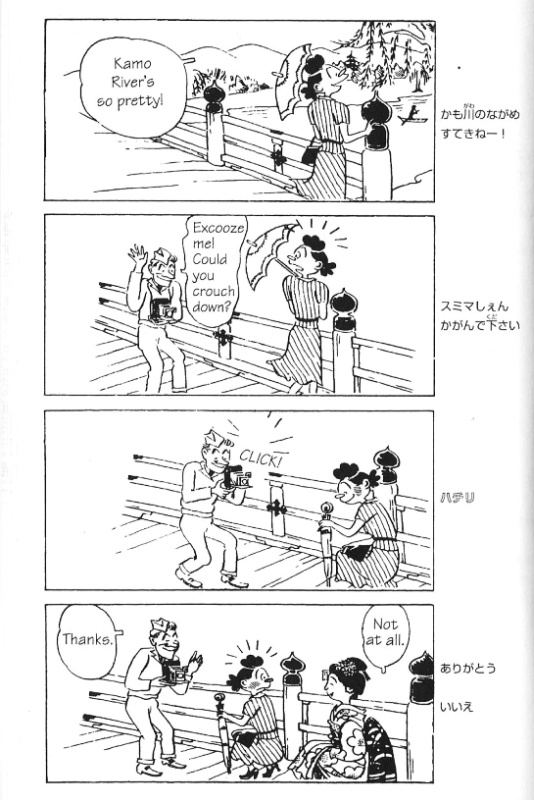In his 1979 interview with Alfred Bergdoll for Cascade Comix, Art Spiegelman refers to comics a “fugitive medium,” saying that “it’s born of the sawdust, you know, rather than the fertile soil.” He goes on to observe,
There’s a funny thing about comics which is that you’ve got to simplify your drawings because you’re working with, more often than not, sharp black and white. You can’t even too successfully, usually, work in grey tones. So you have to simplify drawings for that reason. You also have the fact that most panels are very small so even if you’re drawing twice as large, you’re still working in an area that would be considered a very small etching, let’s say, with a maximum of five or six inches high. And you also have the fact that you have to simplify the gesture to make it communicate quickly because it’s a kind of picture writing. And you have the fact that you can’t fit that much text into any one panel, so you have to simplify your text and therefore, to do something really potent you have to suggest much, much more than you can actually state. And in that sense, maybe comics have more in common with poetry than with prose. And that’s merely a limitation that the medium presents …
While his “fugitive medium” comment could be read as an expressing understanding of the limitations of comics as a medium, I think Spiegelman goes on to clarify that by adding “born of sawdust” he’s also talking about the audience expectations of comics at the time:
… but every medium has its limitations and it’s incumbent on the artist to deal with those and make the most of it. Limitations can be turned to an advantage. And on the other hand one, one of the problems with comics is, well, for one thing, they’re called comic strips so they’re expected to give you a boffo laugh, or I guess at most they’re expected to give you some escapist super hero entertainment or something, but they’re not really expected to do more than be a vehicle for mass medium entertainment. So it doesn’t really attract artists to come along and grapple with the material because that’s not what it’s billed as. And it doesn’t attract an audience who’s serious for the most part. Serious audiences are probably at least as important as serious artists.
After Bergdoll points out that “there are not many more serious comics fans than there are comic artists, Spiegelman continues, “I think that the problem of audience is a major one. It’s very important for people to be willing to stretch themselves to meet the work rather than to have the work poured down their sleeping, open gullets.”
Later, in his 1980 interview with Dean Mullaney for Comics Feature, Spiegelman discusses how prominent segments of the underground comics culture had begun to ossify, due in large part in his estimation to publishers responding to audience expectations that alternative comics were largely about sex, violence, and drugs. With first Arcade and then the much larger format RAW, he and Françoise Mouly try to break away from historic expectations about graphic storytelling to foster a new audience and perhaps a fertile soil:
It’s just that we wanted to see a new context for the material. And that’s RAW. I think it exudes a certain kind of class and elegance. I think it’s an interesting tension because comics, in America at least, are considered this real gutter medium. To have that tension between an elegant format and a medium we’re used to thinking of as junk literature makes you look at the work in a different way. The risk it runs is seeming pretentious. The risk is worth it because it asks for an involvement on the part of an audience that’s much more intense than the audience is used to giving a comic. That makes a different kind of work happen. It’s one possibility of what we want to see happen to comics in the future, and we certainly want to explore it.
The supposition that fostering a new and differently engaged audience would foster and make more possible different kinds of work from comic and graphic artists is an interesting one. After a back and forth with Mullaney, Spiegelman continues:
An important part of the equation that’s usually left out is that the audience is as important as the artist. The audience determines what’s possible, and right now the audience expects and receives this stuff that you’re supposed to lean back and let hit you for a second, and then go away somewhere else. Nothing is asked of you as an audience; you’re not asked to participate in a piece of work and give it your attention, give it your energy and thereby reap a far richer reward than you would from the kind of material that doesn’t require any effort. Hopefully, we’ll find that kind of an audience. We’d like to do real art that has an audience.
I’m drawn to Spiegelman’s thoughts about the role of audience and its importance to what can grow artistically within the medium of comics. I think his observations could be used to build a framework with which to begin a class on graphic storytelling, which I do hope to develop in the coming year. Getting students to look at expectations and assumptions can form an important part of first week pedagogy.
I’m still developing my formative thoughts on the importance of Con audiences and of cosplay community and culture, bubbling up through my last post, and I’m still reflecting on Bart Beaty’s art world idea as shared in my review of his book Comics versus Art, so I’m sure reflecting on audience roles and functions in the development of graphic storytelling will be a recurring theme of this blog.


